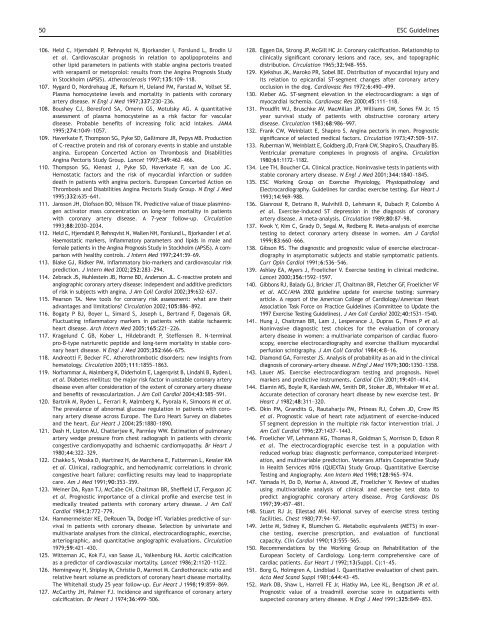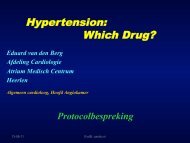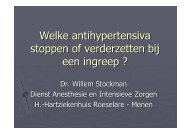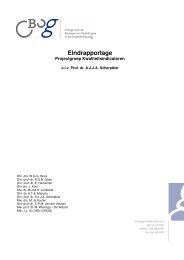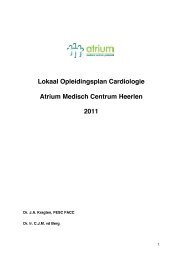Guidelines on the Management of Stable Angina Pectoris ... - Cardio
Guidelines on the Management of Stable Angina Pectoris ... - Cardio
Guidelines on the Management of Stable Angina Pectoris ... - Cardio
You also want an ePaper? Increase the reach of your titles
YUMPU automatically turns print PDFs into web optimized ePapers that Google loves.
50 ESC <str<strong>on</strong>g>Guidelines</str<strong>on</strong>g>106. Held C, Hjemdahl P, Rehnqvist N, Bjorkander I, Forslund L, Brodin Uet al. <strong>Cardio</strong>vascular prognosis in relati<strong>on</strong> to apolipoproteins ando<strong>the</strong>r lipid parameters in patients with stable angina pectoris treatedwith verapamil or metoprolol: results from <strong>the</strong> <strong>Angina</strong> Prognosis Studyin Stockholm (APSIS). A<strong>the</strong>rosclerosis 1997;135:109–118.107. Nygard O, Nordrehaug JE, Refsum H, Ueland PM, Farstad M, Vollset SE.Plasma homocysteine levels and mortality in patients with cor<strong>on</strong>aryartery disease. N Engl J Med 1997;337:230–236.108. Boushey CJ, Beresford SA, Omenn GS, Motulsky AG. A quantitativeassessment <strong>of</strong> plasma homocysteine as a risk factor for vasculardisease. Probable benefits <strong>of</strong> increasing folic acid intakes. JAMA1995;274:1049–1057.109. Haverkate F, Thomps<strong>on</strong> SG, Pyke SD, Gallimore JR, Pepys MB. Producti<strong>on</strong><strong>of</strong> C-reactive protein and risk <strong>of</strong> cor<strong>on</strong>ary events in stable and unstableangina. European C<strong>on</strong>certed Acti<strong>on</strong> <strong>on</strong> Thrombosis and Disabilities<strong>Angina</strong> <strong>Pectoris</strong> Study Group. Lancet 1997;349:462–466.110. Thomps<strong>on</strong> SG, Kienast J, Pyke SD, Haverkate F, van de Loo JC.Hemostatic factors and <strong>the</strong> risk <strong>of</strong> myocardial infarcti<strong>on</strong> or suddendeath in patients with angina pectoris. European C<strong>on</strong>certed Acti<strong>on</strong> <strong>on</strong>Thrombosis and Disabilities <strong>Angina</strong> <strong>Pectoris</strong> Study Group. N Engl J Med1995;332:635–641.111. Janss<strong>on</strong> JH, Ol<strong>of</strong>ss<strong>on</strong> BO, Nilss<strong>on</strong> TK. Predictive value <strong>of</strong> tissue plasminogenactivator mass c<strong>on</strong>centrati<strong>on</strong> <strong>on</strong> l<strong>on</strong>g-term mortality in patientswith cor<strong>on</strong>ary artery disease. A 7-year follow-up. Circulati<strong>on</strong>1993;88:2030–2034.112. Held C, Hjemdahl P, Rehnqvist N, Wallen NH, Forslund L, Bjorkander I et al.Haemostatic markers, inflammatory parameters and lipids in male andfemale patients in <strong>the</strong> <strong>Angina</strong> Prognosis Study in Stockholm (APSIS). A comparis<strong>on</strong>with healthy c<strong>on</strong>trols. J Intern Med 1997;241:59–69.113. Blake GJ, Ridker PM. Inflammatory bio-markers and cardiovascular riskpredicti<strong>on</strong>. J Intern Med 2002;252:283–294.114. Zebrack JS, Muhlestein JB, Horne BD, Anders<strong>on</strong> JL. C-reactive protein andangiographic cor<strong>on</strong>ary artery disease: independent and additive predictors<strong>of</strong> risk in subjects with angina. J Am Coll <strong>Cardio</strong>l 2002;39:632–637.115. Pears<strong>on</strong> TA. New tools for cor<strong>on</strong>ary risk assessment: what are <strong>the</strong>iradvantages and limitati<strong>on</strong>s? Circulati<strong>on</strong> 2002;105:886–892.116. Bogaty P BJ, Boyer L, Simard S, Joseph L, Bertrand F, Dagenais GR.Fluctuating inflammatory markers in patients with stable ischaemicheart disease. Arch Intern Med 2005;165:221–226.117. Kragelund C GB, Kober L, Hildebrandt P, Steffensen R. N-terminalpro-B-type natriuretic peptide and l<strong>on</strong>g-term mortality in stable cor<strong>on</strong>aryheart disease. N Engl J Med 2005;352:666–675.118. Andreotti F, Becker FC. A<strong>the</strong>rothrombotic disorders: new insights fromhematology. Circulati<strong>on</strong> 2005;111:1855–1863.119. Norhammar A, Malmberg K, Diderholm E, Lagerqvist B, Lindahl B, Ryden Let al. Diabetes mellitus: <strong>the</strong> major risk factor in unstable cor<strong>on</strong>ary arterydisease even after c<strong>on</strong>siderati<strong>on</strong> <strong>of</strong> <strong>the</strong> extent <strong>of</strong> cor<strong>on</strong>ary artery diseaseand benefits <strong>of</strong> revascularizati<strong>on</strong>. J Am Coll <strong>Cardio</strong>l 2004;43:585–591.120. Bartnik M, Ryden L, Ferrari R, Malmberg K, Pyorala K, Simo<strong>on</strong>s M et al.The prevalence <strong>of</strong> abnormal glucose regulati<strong>on</strong> in patients with cor<strong>on</strong>aryartery disease across Europe. The Euro Heart Survey <strong>on</strong> diabetesand <strong>the</strong> heart. Eur Heart J 2004;25:1880–1890.121. Dash H, Lipt<strong>on</strong> MJ, Chatterjee K, Parmley WW. Estimati<strong>on</strong> <strong>of</strong> pulm<strong>on</strong>aryartery wedge pressure from chest radiograph in patients with chr<strong>on</strong>icc<strong>on</strong>gestive cardiomyopathy and ischaemic cardiomyopathy. Br Heart J1980;44:322–329.122. Chakko S, Woska D, Martinez H, de Marchena E, Futterman L, Kessler KMet al. Clinical, radiographic, and hemodynamic correlati<strong>on</strong>s in chr<strong>on</strong>icc<strong>on</strong>gestive heart failure: c<strong>on</strong>flicting results may lead to inappropriatecare. Am J Med 1991;90:353–359.123. Weiner DA, Ryan TJ, McCabe CH, Chaitman BR, Sheffield LT, Fergus<strong>on</strong> JCet al. Prognostic importance <strong>of</strong> a clinical pr<strong>of</strong>ile and exercise test inmedically treated patients with cor<strong>on</strong>ary artery disease. J Am Coll<strong>Cardio</strong>l 1984;3:772–779.124. Hammermeister KE, DeRouen TA, Dodge HT. Variables predictive <strong>of</strong> survivalin patients with cor<strong>on</strong>ary disease. Selecti<strong>on</strong> by univariate andmultivariate analyses from <strong>the</strong> clinical, electrocardiographic, exercise,arteriographic, and quantitative angiographic evaluati<strong>on</strong>s. Circulati<strong>on</strong>1979;59:421–430.125. Witteman JC, Kok FJ, van Saase JL, Valkenburg HA. Aortic calcificati<strong>on</strong>as a predictor <strong>of</strong> cardiovascular mortality. Lancet 1986;2:1120–1122.126. Hemingway H, Shipley M, Christie D, Marmot M. <strong>Cardio</strong>thoracic ratio andrelative heart volume as predictors <strong>of</strong> cor<strong>on</strong>ary heart disease mortality.The Whitehall study 25 year follow-up. Eur Heart J 1998;19:859–869.127. McCarthy JH, Palmer FJ. Incidence and significance <strong>of</strong> cor<strong>on</strong>ary arterycalcificati<strong>on</strong>. Br Heart J 1974;36:499–506.128. Eggen DA, Str<strong>on</strong>g JP, McGill HC Jr. Cor<strong>on</strong>ary calcificati<strong>on</strong>. Relati<strong>on</strong>ship toclinically significant cor<strong>on</strong>ary lesi<strong>on</strong>s and race, sex, and topographicdistributi<strong>on</strong>. Circulati<strong>on</strong> 1965;32:948–955.129. Kjekshus JK, Maroko PR, Sobel BE. Distributi<strong>on</strong> <strong>of</strong> myocardial injury andits relati<strong>on</strong> to epicardial ST-segment changes after cor<strong>on</strong>ary arteryocclusi<strong>on</strong> in <strong>the</strong> dog. <strong>Cardio</strong>vasc Res 1972;6:490–499.130. Kleber AG. ST-segment elevati<strong>on</strong> in <strong>the</strong> electrocardiogram: a sign <strong>of</strong>myocardial ischemia. <strong>Cardio</strong>vasc Res 2000;45:111–118.131. Proudfit WJ, Bruschke AV, MacMillan JP, Williams GW, S<strong>on</strong>es FM Jr. 15year survival study <strong>of</strong> patients with obstructive cor<strong>on</strong>ary arterydisease. Circulati<strong>on</strong> 1983;68:986–997.132. Frank CW, Weinblatt E, Shapiro S. <strong>Angina</strong> pectoris in men. Prognosticsignificance <strong>of</strong> selected medical factors. Circulati<strong>on</strong> 1973;47:509–517.133. Ruberman W, Weinblatt E, Goldberg JD, Frank CW, Shapiro S, Chaudhary BS.Ventricular premature complexes in prognosis <strong>of</strong> angina. Circulati<strong>on</strong>1980;61:1172–1182.134. Lee TH, Boucher CA. Clinical practice. N<strong>on</strong>invasive tests in patients withstable cor<strong>on</strong>ary artery disease. N Engl J Med 2001;344:1840–1845.135. ESC Working Group <strong>on</strong> Exercise Physiology, Physiopathology andElectrocardiography. <str<strong>on</strong>g>Guidelines</str<strong>on</strong>g> for cardiac exercise testing. Eur Heart J1993;14:969–988.136. Gianrossi R, Detrano R, Mulvihill D, Lehmann K, Dubach P, Colombo Aet al. Exercise-induced ST depressi<strong>on</strong> in <strong>the</strong> diagnosis <strong>of</strong> cor<strong>on</strong>aryartery disease. A meta-analysis. Circulati<strong>on</strong> 1989;80:87–98.137. Kwok Y, Kim C, Grady D, Segal M, Redberg R. Meta-analysis <strong>of</strong> exercisetesting to detect cor<strong>on</strong>ary artery disease in women. Am J <strong>Cardio</strong>l1999;83:660–666.138. Gibs<strong>on</strong> RS. The diagnostic and prognostic value <strong>of</strong> exercise electrocardiographyin asymptomatic subjects and stable symptomatic patients.Curr Opin <strong>Cardio</strong>l 1991;6:536–546.139. Ashley EA, Myers J, Froelicher V. Exercise testing in clinical medicine.Lancet 2000;356:1592–1597.140. Gibb<strong>on</strong>s RJ, Balady GJ, Bricker JT, Chaitman BR, Fletcher GF, Froelicher VFet al. ACC/AHA 2002 guideline update for exercise testing: summaryarticle. A report <strong>of</strong> <strong>the</strong> American College <strong>of</strong> <strong>Cardio</strong>logy/American HeartAssociati<strong>on</strong> Task Force <strong>on</strong> Practice <str<strong>on</strong>g>Guidelines</str<strong>on</strong>g> (Committee to Update <strong>the</strong>1997 Exercise Testing <str<strong>on</strong>g>Guidelines</str<strong>on</strong>g>). J Am Coll <strong>Cardio</strong>l 2002;40:1531–1540.141. Hung J, Chaitman BR, Lam J, Lesperance J, Dupras G, Fines P et al.N<strong>on</strong>invasive diagnostic test choices for <strong>the</strong> evaluati<strong>on</strong> <strong>of</strong> cor<strong>on</strong>aryartery disease in women: a multivariate comparis<strong>on</strong> <strong>of</strong> cardiac fluoroscopy,exercise electrocardiography and exercise thallium myocardialperfusi<strong>on</strong> scintigraphy. J Am Coll <strong>Cardio</strong>l 1984;4:8–16.142. Diam<strong>on</strong>d GA, Forrester JS. Analysis <strong>of</strong> probability as an aid in <strong>the</strong> clinicaldiagnosis <strong>of</strong> cor<strong>on</strong>ary-artery disease. N Engl J Med 1979;300:1350–1358.143. Lauer MS. Exercise electrocardiogram testing and prognosis. Novelmarkers and predictive instruments. <strong>Cardio</strong>l Clin 2001;19:401–414.144. Elamin MS, Boyle R, Kardash MM, Smith DR, Stoker JB, Whitaker W et al.Accurate detecti<strong>on</strong> <strong>of</strong> cor<strong>on</strong>ary heart disease by new exercise test. BrHeart J 1982;48:311–320.145. Okin PM, Grandits G, Rautaharju PM, Prineas RJ, Cohen JD, Crow RSet al. Prognostic value <strong>of</strong> heart rate adjustment <strong>of</strong> exercise-inducedST segment depressi<strong>on</strong> in <strong>the</strong> multiple risk factor interventi<strong>on</strong> trial. JAm Coll <strong>Cardio</strong>l 1996;27:1437–1443.146. Froelicher VF, Lehmann KG, Thomas R, Goldman S, Morris<strong>on</strong> D, Eds<strong>on</strong> Ret al. The electrocardiographic exercise test in a populati<strong>on</strong> withreduced workup bias: diagnostic performance, computerized interpretati<strong>on</strong>,and multivariable predicti<strong>on</strong>. Veterans Affairs Cooperative Studyin Health Services #016 (QUEXTA) Study Group. Quantitative ExerciseTesting and Angiography. Ann Intern Med 1998;128:965–974.147. Yamada H, Do D, Morise A, Atwood JE, Froelicher V. Review <strong>of</strong> studiesusing multivariable analysis <strong>of</strong> clinical and exercise test data topredict angiographic cor<strong>on</strong>ary artery disease. Prog <strong>Cardio</strong>vasc Dis1997;39:457–481.148. Stuart RJ Jr, Ellestad MH. Nati<strong>on</strong>al survey <strong>of</strong> exercise stress testingfacilities. Chest 1980;77:94–97.149. Jette M, Sidney K, Blumchen G. Metabolic equivalents (METS) in exercisetesting, exercise prescripti<strong>on</strong>, and evaluati<strong>on</strong> <strong>of</strong> functi<strong>on</strong>alcapacity. Clin <strong>Cardio</strong>l 1990;13:555–565.150. Recommendati<strong>on</strong>s by <strong>the</strong> Working Group <strong>on</strong> Rehabilitati<strong>on</strong> <strong>of</strong> <strong>the</strong>European Society <strong>of</strong> <strong>Cardio</strong>logy. L<strong>on</strong>g-term comprehensive care <strong>of</strong>cardiac patients. Eur Heart J 1992;13(Suppl. C):1–45.151. Borg G, Holmgren A, Lindblad I. Quantitative evaluati<strong>on</strong> <strong>of</strong> chest pain.Acta Med Scand Suppl 1981;644:43–45.152. Mark DB, Shaw L, Harrell FE Jr, Hlatky MA, Lee KL, Bengts<strong>on</strong> JR et al.Prognostic value <strong>of</strong> a treadmill exercise score in outpatients withsuspected cor<strong>on</strong>ary artery disease. N Engl J Med 1991;325:849–853.


